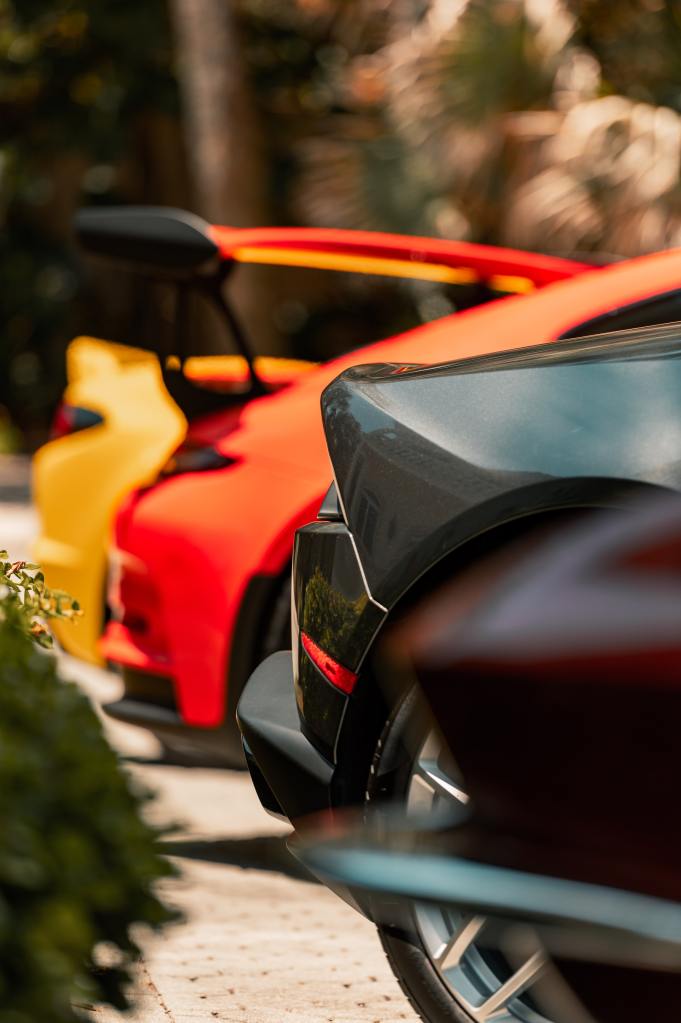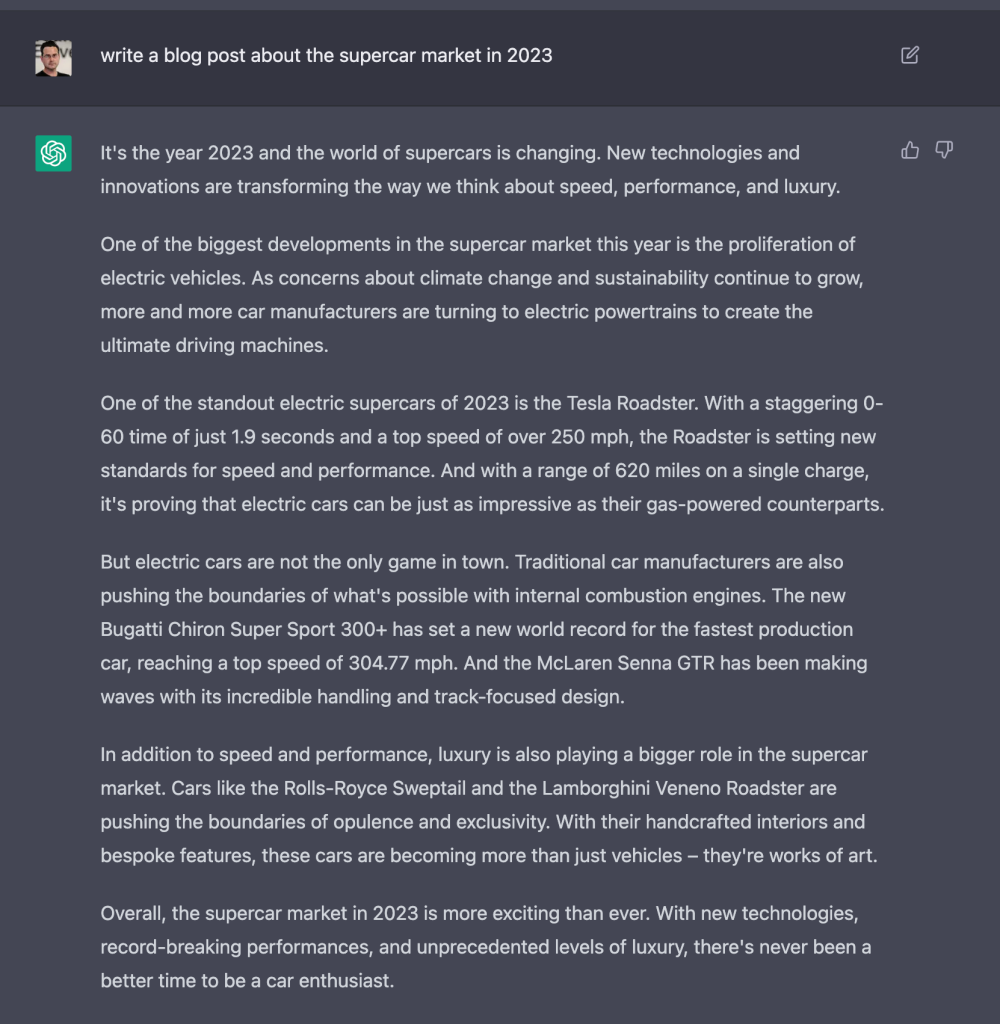We’ve been doing a bit of consultancy work into the high net worth (HNWI) and the ultra HNWIs in the second half of this year. One of the areas that always comes up is ownership and role of cars. It used to be quite easy, but change is happening fast. Here’s some thoughts. Oh and as an added bonus, I popped the same question into the ChatGPT AI thingy that’s got everyone excited. Overly it would seem but you may prefer the artificial version.
//
From driveway envy to driveway curiosity.
The supercar market in 2023 and beyond.
The supercar market, despite the everyday headlines of doom and gloom on inflation and mortgage rates, is largely shielded due to the HNWI wealth. But the market has been, and will continue to evolve.
The obvious change is the forced acceleration of electrification. Most of the major marques are already either in hybrid or pure electric, with the effect that the price tags of high end “mass cars” are now encroaching on the “entry level” of the super cars. A Porsche Taycan, fully spec’d is nudging up the Ferrari Roma. The Mercedes EQS is the wrong or right side of €100,000 dependent on your wallet size. Even the new Polestar 3 announced recently is tagged at nearly €100,000. An eye-watering amount for a brand that was, until lately, the performance off-shoot of Volvo. And the new EX90 all-electric version of the Volvo’s flagship XC90 is pegged at €100,000.

The pressure from below to traditional supercar marques is also being felt sideways, new entrants are muscling in based on EV pure plays. Brands such as Rivian, Fisker and Aehra (and a list that is getting longer by the week) don’t have the heritage (or as Fisker may be hoping, short memories). But Tesla have paved the way and done the hard yards here; you don’t need heritage if you can compete on IWOOT/FOMO fever with Ludicrous Mode and the like. As much about showing off with the latest gadget than the heritage and prestige. And of course, in Tesla’s case, a robust and well-connected charging network to take away the range reality oft-perceived as range anxiety in the minds of drivers not yet ready to commit.
A stocky slab of non-slippery bodywork with an elephant-size stomp on the scales would appear to be the antithesis of the supercar territory.
But perhaps a bigger shift than EV new entrants is the widening of the audience from the traditional male audience who want the purist 2-seat, rear wheel drive super car. The APAC and Middle East markets have a strong affinity with SUVs and buy them in droves. North America is the home of bigger is better and they just love their home grown SRTs and the like. But the SUV explosion is fired by females and families. A stocky slab of non-slippery bodywork with an elephant-size stomp on the scales would appear to be the antithesis of the supercar territory. But the phenomenal rise of SUVs in mass has broken the dam. Nissan’s Qashqai started the movement and brands up the premium ladder quickly took notice; the Cayenne is now Porsche’s highest volume selling vehicle.

Lamborghini’s Urus is essentially an Audi with Lambo styling, but this did the dual trick for Bologna’s finest: it sorted out their poor reliability perception with a thick slice of Vorspung Durch Technik and made the Urus appealing to females and families who wanted a touch of prestige, luxury and performance as well as being able to lug all the stuff a family, even a very wealthy one, needs. It also makes a stereotypical appearance in the car park of Arsenal FC in their Amazon Prime ‘All or Nothing’ series. One can question whether that helps or hinders the brand in as much the same way as Aston Martin’s foray into a partnership with Stormzy was loved and loathed in equal measure. The trend spotters applauding the unconventional move, the establishment raising an overgrown eyebrow in bemusement.
Aston Martin’s DBX borrows heavily from Mercedes-Benz to assuage their own glut of reliability issues. There’s only so much Daniel Craig can do on the big screen. Even at the luxury end, Rolls Royce and Bentley SUVs are now no longer a surprise on the streets on Chelsea and Downtown Miami. They just are.
Ferrari have entered the SUV territory as well as the entry level supercar meaning their brand exclusivity may be eroded to the purists, but this just seems to have fueled desire. Speaking to Ferrari dealers, the announcement of the Purosangue SUV (pure blood – the name evokes performance rather than functional packing space) and the Roma have brought in more serious prospects than F1 does on a race weekend. But they also acknowledge that 75 years of pure-bred race heritage plays into the mystique of the brand, and they claim they are fully sold out for at least the next two years, and they feel emboldened to continue to act in a detached way. “People come to Ferrari, not the other way around.” A sense of the brand being bigger than the driver.
“People come to Ferrari, not the other way around”
All of this means that the dynamics of the game are changing. Where you used to buy a supercar perhaps to show off your wealth, the dual combination of societal pressures – particularly in China and Russia of dialling down external shows of wealth – and also the massively increased competition for your increasingly earned rather than inherited wealth. There’s also the role that electrification plays. Even the Top Gear presenters enjoying the anonymity of a Ferrari 296 GTB in pure electric mode. And effectively sounding the death knell for top-speed and pure acceleration of ICE models as the Rimac Nivera gave a comically large head-start to a Lamborghini and trounced it.
The rise of the SUVs and the new entrants give the HNWI audience more choice than ever and with that comes more opportunities to express their individuality more than ever. Traditional brands have relied for so long on people belonging to their tribes, bound by history, heritage and a collective sense of belonging. The emotions of belonging to a tribe are incredibly strong. But temptation is just around the corner. Temptation in different shapes and with different names. Especially if, as a manufacturer, you are only just entering the SUV category, you’re already some way behind the curve.
And electrification brings a different level of headache: software reliability. Where brands that have not been, shall we say, renowned for reliability in the past, the skateboard-style approach to EV production puts ever more reliance on the software over the bits that explode and hum and thwang beneath the bonnet. The bastion of uber-reliability, VW is suffering a lot of software issues on their much-vaunted ID range and McLaren’s Artura was delayed for nearly two years due to software issues. The battleground may be moving into technology reassurance against the ‘will it start on a cold morning in November’ hope. It’s a hugely exciting time of change in the automotive industry but whether start-up or heritage brand, mental and physical availability must remain a priority in understanding where to reach the HNWI audience and perhaps turn driveway envy into driveway curiosity.
Image credits:
Photo by Colin Lloyd on Unsplash , photo by Krish Parmar on Unsplash
//
And here’s the ChatGPT version:

![[bluurb] stuff and things](https://bluurb.files.wordpress.com/2021/01/cropped-a33a6dad-0d66-4aaa-bb33-661beb2fd126.jpeg)